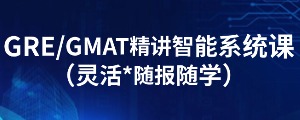选课中心
7099人选课
GMAT公开讲座
0元
GRE公开讲座
0元
一对一体验课
99元
GMAT模考网站
10000人
GRE模考网站
GMAT课程
GRE课程
托福辅导课程
【定制】1v1
私人订制
资料下载
考前冲刺

扫码添加助教
免费领取
备考资料大礼包

扫码关注公众号
新东方在线GMAT频道为大家带来GMAT阅读文章练习三十五,希望对大家GMAT备考有所帮助。更多精彩尽请关注新东方在线GMAT频道!
Kazuko Nakane’s history of the early Japanese immigrants to central California’s PajaroValley focuses on the development of farming communities there from1890 to 1940. The Issei (first-generation immigrants)(5) were brought into the PajaroValley to raise sugar beets.
Like Issei laborers in American cities, Japanese men in rural areas sought employment via the “boss” system.The system comprised three elements: immigrant wage laborers; Issei boardinghouses where laborers stayed;(10) and labor contractors, who gathered workers for a particular job and then negotiated a contract between workers and employer. This same system was originally utilized by the Chinese laborers who had preceded the Japanese. A related institution was the “labor club,”(15)which provided job information and negotiated employment contracts and other legal matters, such as the rental of land, for Issei who chose to belong and paid an annual fee to the cooperative for membership.
When the local sugar beet industry collapsed in 1902,(20) the Issei began to lease land from the valley’s strawberry farmers. The Japanese provided the labor and the crop was divided between laborers and landowners. The Issei began to operate farms, they began to marry and start families, forming an established Japanese American(30) community. Unfortunately, the Issei’s efforts to attain agricultural independence were hampered by government restrictions, such as the Alien Land Law of 1913.But immigrants could circumvent such exclusionary laws by leasing or purchasing land in their American-born(35) children’s names.
Nakane’s case study of one rural Japanese American community provides valuable information about the lives and experiences of the Isseil. It is, however, too particularistic. This limitation derives from Nakane’s(40)methodology—that of oral history—which cannot substitute for a broader theoretical or comparative perspective. Furture research might well consider two issues raised by her study: were the Issei of the PajaroValley similar to or different from Issei in urban settings,(45) and what variations existed between rural Japanese American communities?
1. The primary purpose of the passage is to
(A) defend a controversial hypothesis presented in a history of early Japanese immigrants to Califronia(B) dismiss a history of an early Japanese settlement in California as narrow and ill constructed
(C) summarize and critique a history of an early Japanese settlement in California
(D) compare a history of one Japanese American community with studies of Japanese settlements throughout California
(E) examine the differences between Japanese and Chinese immigrants to central California in the 1890’s
2. Which of the following best describes a “labor club,” as defined in the passage?
(A) An organization to which Issei were compelled to belong if they sought employment in the PajaroValley
(B) An association whose members included labor contractors and landowning “bosses”
(C) A type of farming corporation set up by Issei who had resided in the PajaroValley for some time
(D) A cooperative association whose members were dues-paying Japanese laborers
(E) A social organization to which Japanese laborers and their families belonged
3. Based on information in the passage, which of the following statements concerning the Alien Land Law of 1913 is most accurate?
(A) It excluded American-born citizens of Japanese ancestry from landownership.
(B) It sought to restrict the number of foreign immigrants to California.
(C) It successfully prevented Issei from ever purchasing farmland.
(D) It was applicable to first-generation immigrants but not to their American-born children.
(E) It was passed under pressure from the PajaroValley’s strawberry farmers.
4. Several Issei families join together to purchase a strawberry field and the necessary farming equipment. Such a situation best exemplifies which of the following, as it is described in the passage?
(A) A typical sharecropping agreement
(B) A farming corporation
(C) A “labor club”
(D) The “boss” system
(E) Circumvention of the AlienLand Law
5. The passage suggests that which of the following was an indirect consequence of the collapse of the sugar beet industry in the PajaroValley?
(A) The Issei formed a permanent, family-based community.
(B) Boardinghouses were built to accommodate the Issei.
(C) The Issei began to lease land in their children’s names.
(D) The Issei adopted a labor contract system similar to that used by Chinese immigrants.
(E) The Issei suffered a massive dislocation caused by unemployment.
6. The author of the passage would most likely agree that which of the following, if it had been included in Nakane’s study, would best remedy the particularistic nature of that study?
(A) A statistical table comparing per capita income of Issei wage laborers and sharecroppers in the PajaroValley
(B) A statistical table showing per capita income of Issei in the PajaroValley from 1890 to 1940
(C) A statistical table showing rates of farm ownership by Japanese Americans in four central California counties from 1890 to 1940
(D) A discussion of original company documents dealing with the PajaroValley sugar beet industry at the turn of the century
(E) Transcripts of interviews conducted with members of the Pajaro Valley Japanese American community who were born in the 1920’s and 1930’s.
7. It can be inferred from the passage that, when the Issei began to lease land from the Valley’s strawberry farmers, the Issei most probably did which of the following?
(A) They used profits made from selling the strawberry crop to hire other Issei.
(B) They negotiated such agricultural contracts using the “boss” system.
(C) They paid for the use of the land with a share of the strawberry crop.
(D) They earned higher wages than when they raised sugar beets.
(E) They violated the Alien Land Law.
以上就为大家整理的“GMAT阅读文章练习三十五”,更多精彩内容,请关注新东方在线GMAT频道。
| GMAT直播VIP小班 | GMAT直播精讲班 | GMAT录播课 |
| (VIP小班/全科班+1对1) | (全科精讲/单项备考) | (全科班/单项班) |
| 72.5课时 ¥18800 | 61课时 ¥7796 | 134课时 ¥14680 |

 资料下载
资料下载
新东方GMAT佛脚词汇1.0版本
发布时间:2023-06-30添加新东方美研助教号
回复【资料】获取
新东方GMAT数学500题资料下载
发布时间:2023-05-26添加新东方美研助教号
回复【资料】获取
新东方GMAT800题资料下载
发布时间:2022-05-21添加新东方美研助教号
回复【资料】获取
1000句GMAT真实句子改错问题
发布时间:2022-04-17添加新东方美研助教号
回复【资料】获取
2024杨鹏阅读难句(GMAT+GRE)教程
发布时间:2022-04-17添加新东方美研助教号
回复【资料】获取
新东方GMAT数学500题(解析及答案)
发布时间:2019-11-27添加新东方美研助教号
回复【资料】获取
新东方GMAT800题(逻辑+语法+阅读)
发布时间:2019-11-27添加新东方美研助教号
回复【资料】获取
新东方GMAT佛脚词汇1.0版本
发布时间:2019-11-27添加新东方美研助教号
回复【资料】获取
GMAT词汇/长难句/语法资料大全
发布时间:2019-11-27添加新东方美研助教号
回复【资料】获取
GMAT语文考试圣经(Bible)电子版
发布时间:2019-11-27关注新东方在线美研订阅号
回复【GMAT】获取
GMAT推理圣经PDF电子版
发布时间:2019-11-27添加新东方美研助教号
回复【资料】获取
GMAT考试OG五个版本题号对照表
发布时间:2019-11-27添加新东方美研助教号
回复【资料】获取
GMAT Ultimate Grammar电子书籍PDF
发布时间:2019-11-27添加新东方美研助教号
回复【资料】获取

添加美研助教号,
回复【GMAT】获取备考必看资料包

 推荐阅读
推荐阅读
新东方在线GMAT频道为大家带来GMAT阅读复习的五大步骤,希望对大家GMAT备考有所帮助。更多精彩尽请关注新东方在线GMAT频道! 1:原来
新东方在线GMAT频道为大家带来GMAT阅读背景的培养,希望对大家GMAT备考有所帮助。更多精彩尽请关注新东方在线GMAT频道! 一、经济学
新东方在线GMAT频道为大家带来GMAT阅读复习效率不高怎么办,希望对大家GMAT备考有所帮助。更多精彩尽请关注新东方在线GMAT频道! 建
新东方在线GMAT频道为大家带来GMAT阅读提高速度的根本方法,希望对大家GMAT备考有所帮助。更多精彩尽请关注新东方在线GMAT频道! 1
新东方在线GMAT频道为大家带来GMAT阅读如何避免错误,希望对大家GMAT备考有所帮助。更多精彩尽请关注新东方在线GMAT频道! 要避免GMA
新东方在线GMAT频道为大家带来GMAT阅读技巧的提升,希望对大家GMAT备考有所帮助。更多精彩尽请关注新东方在线GMAT频道! GMAT阅读推
新东方在线GMAT频道为大家带来GMAT阅读备考的注意事项,希望对大家GMAT备考有所帮助。更多精彩尽请关注新东方在线GMAT频道! GMAT阅
新东方在线GMAT频道为大家带来GMAT阅读怎么提高自己的能力,希望对大家GMAT备考有所帮助。更多精彩尽请关注新东方在线GMAT频道! 建
新东方在线GMAT频道为大家带来GMAT阅读长句子的备考,希望对大家GMAT备考有所帮助。更多精彩尽请关注新东方在线GMAT频道! 1 首先
新东方在线GMAT频道为大家带来GMAT阅读水平怎么提高,希望对大家GMAT备考有所帮助。更多精彩尽请关注新东方在线GMAT频道! 下面就来


 GRE/GMAT直播精讲小班
GRE/GMAT直播精讲小班
 GRE/GMAT精讲智能系统课
GRE/GMAT精讲智能系统课
 托福直播/精讲课(30天/60天)
托福直播/精讲课(30天/60天)
 资料下载
资料下载
添加新东方美研助教号
回复【资料】获取
添加新东方美研助教号
回复【资料】获取
添加新东方美研助教号
回复【资料】获取
添加新东方美研助教号
回复【资料】获取
添加新东方美研助教号
回复【资料】获取
添加新东方美研助教号
回复【资料】获取
添加新东方美研助教号
回复【资料】获取
添加新东方美研助教号
回复【资料】获取
添加新东方美研助教号
回复【资料】获取
关注新东方在线美研订阅号
回复【GMAT】获取
添加新东方美研助教号
回复【资料】获取
添加新东方美研助教号
回复【资料】获取
添加新东方美研助教号
回复【资料】获取

 阅读排行榜
阅读排行榜
 相关内容
相关内容